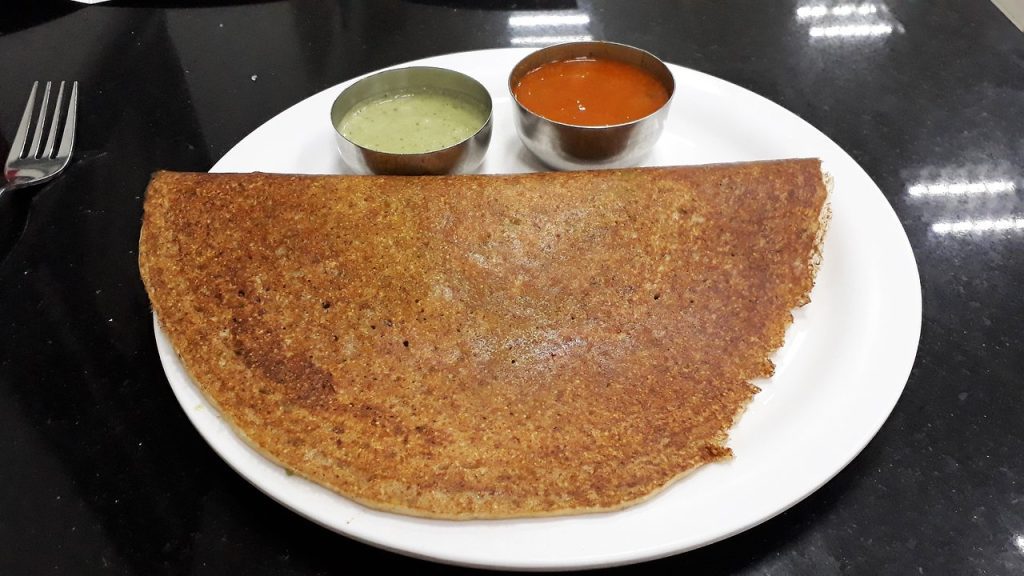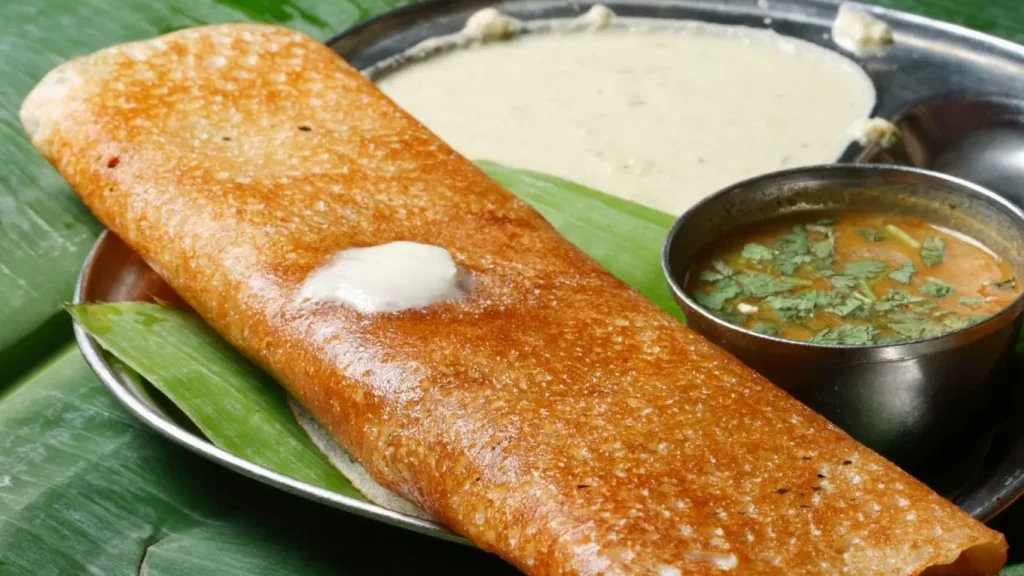Learn about What is Sagu Masala Dosa. Discover Sagu Masala Dosa, a delicious South Indian dish featuring crispy dosa filled with spiced potato filling, served with chutney.
Introduction
The Sagu masala dosa is a popular delicacy hailing from southern India comprising deep-fried, crisp, fermented rice and lentil pancake with a sage stuffing made of potatoes. The sagu filling generally contains boiled potatoes or their paste and also strawberries, cooked onion, ginger, green chilies, and some spices especially cumin and turmeric, often with a dressing of coriander leaves. The dosa is prepared from a batter of soaked rice and urad dal, which rests overnight to give it a tangy taste.
Best Sagu Masala Dosa is always served steaming hot as it enhances the appeal and adds up the flavors. It is commonly accompanied by coconut chutney, tomato chutney, and sambar. This cuisine is extremely tasty and it also gives health benefits which include carbohydrates, fibers, and proteins in such a manner that it can easily be summed up as a gastronomic delight loved by every traveler around the world which can conveniently be breakfast, lunch, or dinner.

What is Sagu?
“Sagu” refers to most of the time the vegetables like Carrots, Peas, Beans, Potatoes, etc., cooked in a coconut milk dress in which a curry or stew is mildly/spiced. The uniqueness of this curry lies in the savoriness of mustard seeds, cumin, and green chilies which are ground with coconut paste sometimes with poppy seeds that add a hint of sweetness to the curry. It is an all-purpose dish and can be served along with rice, chapati, and especially dosas.
Key Ingredients in Sagu Masala Dosa
To create Sagu Masala Dosa, one requires three essential ingredients: dosa batter, sage stuffing, and side dishes. Let us discuss them in detail:
- Dosa Batter: From rice and urad dal, this batter is prepared and left to ferment for optimum sourness and consistency. The process of fermentation is essential as it gives a pleasant tangy flavor along with crispness upon cooking.
- Sagu Filling: Fillings usually consist of vegetables like carrots, peas, beans, and mashed potato and seasonings like coconut, ginger, green chilies, cumin, and coriander. Firstly, the spices are tempered in hot oil or ghee followed by adding vegetables and coconut paste to give it a creamy finish.
- Accompaniments: Sag Masala dosa generally comes served with sides of coconut chutney and sambar that are not in any way lost in the taste balance concerning the filling, which is equally sour and spicy with a tinge of sweetness from the dosa.
How to Make Sagu Masala Dosa
Masala dosa preparation, in a full sense, can be said to have three different steps-preparation of the batter, preparation of the materials, and preparing the dosa. Following is a general scheme outlining the activities of the center:
Step 1: Preparing the Dosa Batter
- Ingredients: Rice, black gram dal, and methi (fenugreek) for tempering.
- Method: First wash and soak the rice and urad dal for around 4 hours. Grind each separately and mix, keep it overnight for fermentation. The batter as a final output must be light and airy so that crisp dosas can be made.
Step 2: Making the Sagu Filling
- Ingredients: – Vegetables (carrot, beans, peas, potato), coconut paste, green chili, cumin, mustard, ginger, curry leaves, and coriander leaves.
- Method: In a heated pan with oil, fry the mustard seeds, cumin, and curry leaves. When fragrant add chopped vegetables and sprinkle some water cover and cook till soft. Make a paste of coconut, green chilies, and ginger and put it into the vegetables. Bring to a boil and cook till the mixture reduces.
Step 3: Cooking and Assembling the Dosa
- Take a ladle of dosa batter and pour it on a hot pan in a circular motion so as to spread it in a thin layer. Pour in the oil on the sides of the batter to make it crispy and wait till it turns golden brown. Place the sage stuffing over the dosa, fold it like a wafer, and serve with chutney and sambar.
Flavor Profile and Texture
Sagu Masala Dosa embraces the crispness of the dosa and the heat subtlety of the vegetable stuffing. There is a pleasing contrast in the sound of the crunch of the dosa with the soft mouthful of the fillings inside the dosa, with the addition of coconut and spices giving an elevation to the food. There is a good balance of spices in the dish, where the green chilies have a mild heat, and the coconut gives in a sweetness.
Health Benefits of Sagu Masala Dosa
Rich in Nutrients
Sagu Masala Dosa is loaded with vegetables thus making it a rich source of vitamins, minerals, and instant energy-giving dietary fiber. This helps the body fight infections, aids in digestive efficiency and increases endurance. Moreover, antioxidants found in most of the vegetables help in cell reproduction making it a healthy option too.
Low-Calorie
The common dosa batter comprising rice and lentils is less oily but protein-rich. This makes it an acceptable ergogenic food, especially for those seeking energy but not keen on excess calories. Also, due to its content, the meal has beneficial features in curbing hunger between meals.
Easy to Digest
Dosa batter, which is fermented before cooking, is also easier on the guts. It is well known that fermented food helps restore the good bacteria in the digestive tract, thus enhancing the absorption of vitamins and digestion in general. For these reasons, Sagu Masala Dosa is not harsh on the digestive system.

Coconut-Based Filling
The saga filling consists of a lot of coconuts which is a source of medium-chain triglycerides (MCTs). Healthy fats, help in the enhancement of energy as well as brain functioning. Coconuts, meanwhile, also contain the fatty acid lauric acid, which is immune-supportive due to its microbial properties. Also, because of these benefits, it utilizes naturally sweet substances rather than just flavoring.
Tips for Perfect Sagu Masala Dosa
- Fermentation: Prepare the dosa batter and allow it to ferment properly for about a day for the perfect balance of density and sourness, which is essential especially when making hard and tasty dosas.
- Thin Dosas: This thin batter should be evenly spread over the hot skillet. The dosa being spread thin gives the chance for healthier crispy dosas enhancing the quality and satisfaction of the meal.
- Flavor Variations: Make the sage filling more delicious by adding ingredients such as paneer or some more seasoning. Flavors can also be targeted to make a difference adding a special touch where nobody knows why each dosa is good but different.
FAQs
What are the best accompaniments for Sagu Masala Dosa?
The Sagu Masala Dosa tastes great when paired with Sudha coconut chutney and tomato chutney along with sambar. It provides a delicious combination enhancing the taste of the dosa which has a crispy character and spicy potato stuffing inside.
How can I store leftover Sagu Masala Dosa?
Sagu Masala Dosa which is unconsumed can be placed in a dry container and refrigerated for a maximum of 2 days. When ready to eat, warm in a frying pan until crisp, especially if the aim is to bring back the original flavor and character.
Is Sagu Masala Dosa vegan?
Sagu Masala Dosa is also vegetarian-friendly as it does not contain animal products. All ingredients included in this dish are plant-based. The dasa batter contains rice and lentils while the potato stuffing is rich in spices and vegetables making it ideal for all vegans.
Can I make Sagu Masala Dosa gluten-free?
Of course, Sagu Masala Dosa is indeed gluten-free as it is mainly composed of rice and lentils. Ensure that in preparing the dish no ingredients whatsoever containing gluten are used so that the dish maintains its gluten-free character.
Conclusion
Sagu Masala Dosa is a burst of serene qualities in the best sense, the pleasure of having Dosa is not only packed with an immense Pakistani appetizing, complex, surprisingly conquering the mild lentils. The quite healthy and relatively bland, yet very tasty food, is suitable for any time of the day. Not having tasted this dosa, no matter if a restaurant or home, does not give justice to this variety due to its unique taste and background simplicity.